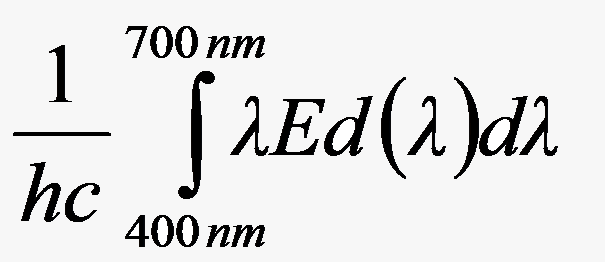Definition of PAR:
The solar energy flux reaching the ocean surface in the spectral range 400-700 nm, referred to as Photo-synthetically Active solar Radiation (PAR). Since photo-system processes are quantum reactions, PAR is defined as the quantum energy flux from the Sun in the spectral range 400-700 nm (Bouvet 2006):

where h and c are respectively the Planck constant and the speed of light in a vacuum and Ed is the downwelling irradiance just above the sea surface. PAR is expressed in Einstein/m2/day. Daily PAR is the average flux during a day (24 hours).
Definition of PP:
Primary production is the ecological term for the rate of photosynthesis of the autotrophic organisms contained in unit volume of seawater. It has dimensions of mass of carbon fixed per unit time per unit volume. Often, the results are integrated through the water column, such that the dimensions are modified to mass of carbon fixed per unit time per unit area of sea surface. When these results are integrated over the day, the dimensions are further modified to mass of carbon fixed per unit area of surface, with the daily time scale implied. Further integration to the annual scale is often used. The most commonly-quoted results are the daily production (mass of carbon fixed) per unit area of sea surface or the annual production per unit area.
Importance of PAR and PP:
The PAR controls the growth of phytoplankton and, therefore, the development of crustaceans, fish, and other consumers (e.g., Kirk, 1994). It ultimately regulates the composition and evolution of marine ecosystems. Knowing the distribution of PAR over the oceans, spatially and temporally, is critical to understanding biogeochemical cycles of carbon, nutrients, and oxygen, and to address important climate and global change issues such as the fate of anthropogenic atmospheric carbon dioxide.
Primary production is synonymous with the rate of photosynthesis and, as such, it is a process forced by light. The active waveband for the process is called the Photosynthetically-Active Radiation (PAR). To estimate primary production, we therefore need information on PAR.
Thermodynamically, ecosystems are dissipative structures, relying for their continuity on a regular energy subsidy from the Sun. The solar input is captured by phytoplankton during the initial stage of primary production. The entire ecosystem is nourished by primary production: without it the ecosystem would collapse. It is fundamental to the sustainability of life in the ocean.
Photosynthesis is also a process that consumes carbon dioxide, with an annual flux of 50 Gigatonnes at the global scale. It is therefore of profound significance to numerical models of the planetary carbon cycle, and hence to predictions concerning the Earth’s climate.



